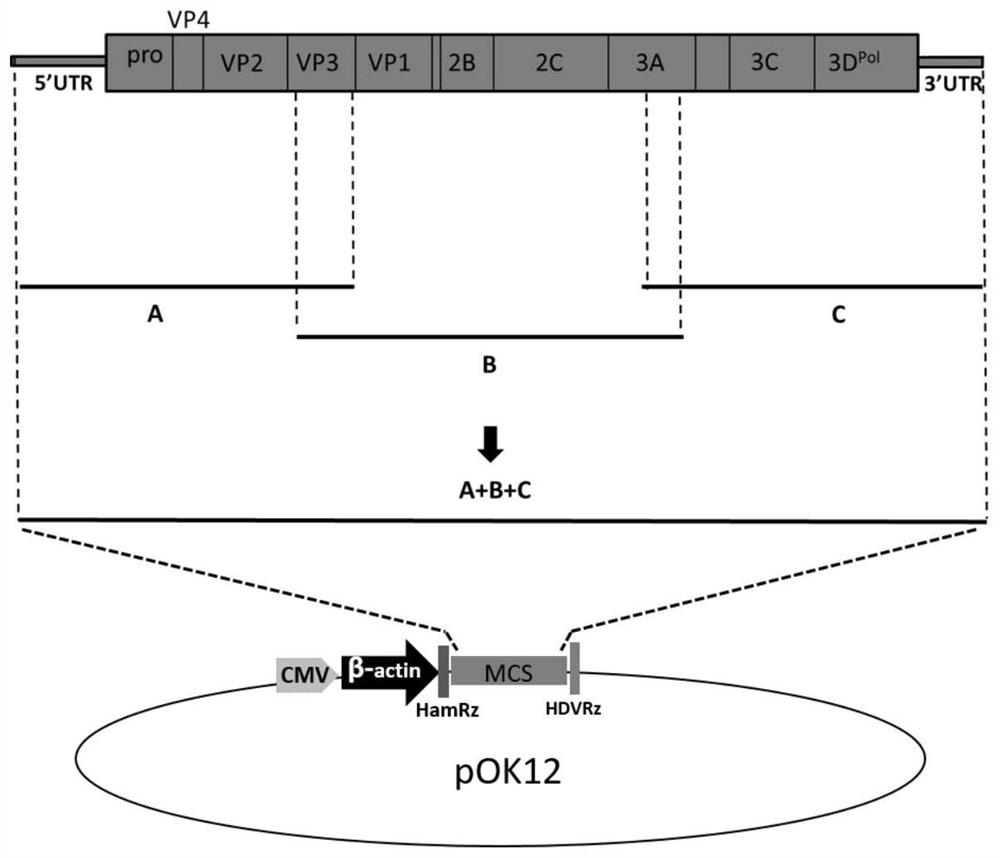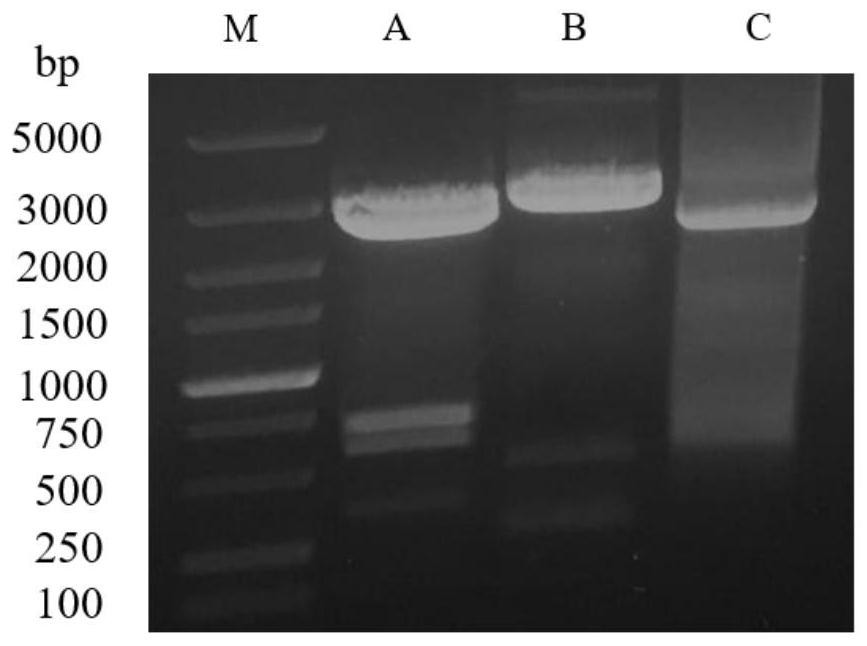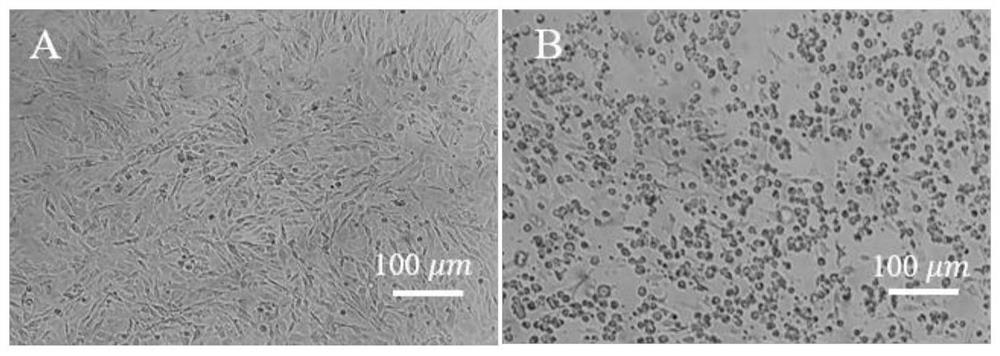Seneca virus A (SVA/HeB) full-length infectious cDNA clone as well as preparation method and application thereof
An infectious cloning and infectious technology, applied in the field of viruses, can solve the problems of complicated operation, unstable reagents, expensive and other problems, and achieve the effects of high cloning efficiency, high rescue ability and high startup efficiency.
- Summary
- Abstract
- Description
- Claims
- Application Information
AI Technical Summary
Problems solved by technology
Method used
Image
Examples
Embodiment 1
[0046] Construction method of infectious clone of Seneca recombinant virus
[0047] Seneca virus type A SVA / HeB (GenBank accession number: MZ375462) was isolated and preserved in this experiment. Based on the SVA genome sequence, through comparative analysis, design amplification primers that introduce rescue elements and cover the entire SVA genome:
[0048] SVA-AF: 5'-CATCATTTTGGCAAAGTGTTAAGCGTCTGATGAGTCCGTGAGGACGAAACTATAGGAAAGGAATTCCTATAGTCTTGAAATGGGGGGCTGGGCCCTCAT-3' (SEQ ID NO. 1);
[0049] SVA-AR: 5'-AGGTCCAACTAGAGTTCAAGCCTATG-3' (SEQ ID NO.2);
[0050] SVA-BF: 5'-CACAACCACAGACCCTTTCTGAA-3' (SEQ ID NO.3);
[0051] SVA-BR: 5'-TGCATTTCCATAAGAGAGAGCGCTC-3' (SEQ ID NO.4);
[0052] SVA-CF: 5'-TAGGAGCGAGAATGCTTATGACGGC-3' (SEQ ID NO.5);
[0053] SVA-CR: 5'-TACCAGATCTGAATCGCCCTCCCTTAGCCATCCGAGTGGACGTGCGTCCTCCTTCGGATGCCCAGGTCGGACCGCGAGGAGGTGGAGATGCCATGCCGACCCTTTTCCCTTTTCTGTTCCGAC-3' (SEQ ID NO. 6);
[0054] In the above specific primers, the EcoR I restriction site homology...
Embodiment 2
[0059] The rescue procedure of recombinant Seneca virus is as follows:
[0060] The recombinant plasmid pOK-rSVA / HeB obtained from Example 1 was inoculated into BHK-21 cells in a 6-well plate, used for transfection when the cells grew to 80%, and 3ug The recombinant plasmid was transfected into BHK-21 cells, and the transfection reagent control and normal cell control were set up at the same time, and placed in a place containing 5% CO 2 In a 37°C incubator, observe the cell state and cell lesions, and harvest the virus when about 80% to 90% of the cells are lesions. After repeated freezing and thawing for 3 times, BHK-21 cells are inoculated again until the virus can stably produce cells. Lesions, cells appear rounded, shed, and there are a lot of floating dead cells. The resulting recombinant virus was named rSVA-HeB, and the image 3 Middle, A: picture of normal control BHK-21 cells; B: rescued recombinant virus rSVA / HeB infected BHK-21.
Embodiment 3
[0062] Culture characteristics of recombinant Seneca virus rSVA / HeB in different cells:
[0063] (1) Infect PK-15 cells with the recombinant Seneca virus rSVA / HeB strain rescued in Example 2, and cause typical cytopathy, which is similar to the wild parent strain SVA / HeB strain in culture characteristics. The lesions caused by rSVA / HeB strain on PK-15 cells are as follows: Figure 4 As shown, where A: picture of normal control PK-15 cells; B: rescued recombinant virus rSVA / HeB infected PK-15.
[0064] (2) Infect IBRS-2 cells with the recombinant Seneca virus rSVA / HeB strain rescued in Example 2, and typical cytopathic changes can be observed, which are similar to the culture characteristics of the wild parent strain SVA / HeB strain. The lesions caused by rSVA / HeB strain on IBRS-2 cells are as follows: Figure 5 Shown, where A: picture of normal control IBRS-2 cells; B: rescued recombinant virus rSVA / HeB infected IBRS-2.
PUM
 Login to view more
Login to view more Abstract
Description
Claims
Application Information
 Login to view more
Login to view more - R&D Engineer
- R&D Manager
- IP Professional
- Industry Leading Data Capabilities
- Powerful AI technology
- Patent DNA Extraction
Browse by: Latest US Patents, China's latest patents, Technical Efficacy Thesaurus, Application Domain, Technology Topic.
© 2024 PatSnap. All rights reserved.Legal|Privacy policy|Modern Slavery Act Transparency Statement|Sitemap



